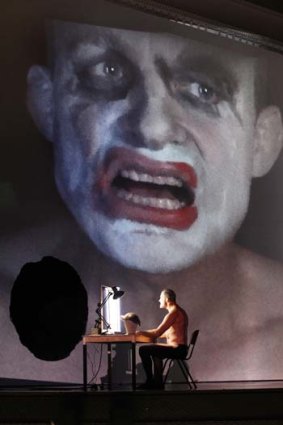By Peter McCallum
A teenager's bedroom and an untidy workshop cramped within a plastered theatrical proscenium arch constructed inside the stage perimeter provided the cluttered space for Siegfried and Mime to irritate each other and enact their dysfunctional relationship for Act 1 of Siegfried.
Mime jiggled tea bags and warmed food in the microwave while Siegfried sulked on his bunk painting animal pictures. By the close of the act Stefan Vinke, as Siegfried, had not only forged the sword on a small barbecue constructed for the purpose - every home should have one - but, after an hour and a quarter of singing, swung the broad phrases of the forging song with thrilling ease.

Ready for his close-up: Melbourne's Ring cycle continues.Credit: Jeff Busby
Despite the wonderful robustness of sound, there was a sense that Vinke was pacing himself, as well he might. A further four hours later he had ample voice to expand the tone and volume to convince Brunhilde by the splendour of his top A flat that he was her sort of hero. This was an outstanding feat of vocal stamina. Graeme Macfarlane gave Mime's whining lines clarity and focus, underscored by transparent balanced textures from the orchestra under Pietari Inkinen.
The proscenium arch is a repeated motif in Robert Cousins' set, becoming a symbol of Siegfried's transgression, which in turn parallels Wagner's own transformation of theatrical convention as he was writing the work.
At the close of Act 1, instead of splitting the anvil Siegfried slashes the plaster wall creating a gaping hole, which becomes the dragon's lair of Act 2. Dragon slain, Siegfried and the wood-bird escape through it, frolicking in the theatre lights which glow at the mention of fire.
In the last act a dazzling golden curtain becomes the ring of fire that Siegfried must puncture to find Brunhilde. It was while writing the third act that Wagner settled on Bayreuth as the site for a purpose-built theatre for the Ring.
In director Neil Armfield's vision, everything in Siegfried happens in a transgressive theatre of the imagination. Robert Donington, in his classic Jungian study, sees the slaying of the dragon Fafner as Siegfried vanquishing the negative feminine and over-strong mother attachment. But equally, Fafner, sitting joylessly with the ring in his cave, represents the end point of Alberich's rape of nature by renouncing love, and Wotan's self-defeating bargains.
Slaying the dragon begins the ring's restoration to love, via Siegfried and Brunhilde's consummation, and to nature. Jud Arthur's poignant entry from the cave as the mortally wounded Fafner, bloodied and completely naked, gave this moment touching humanity as he warns the repentant Siegfried of the ring's power.
In the next great turning point, Terje Stensvold as Wotan visits earth-goddess Erda, appearing frail and wheelchair-bound, mouthing words sung with dark expressiveness by Deborah Humble. In this scene and in the crucial following one, when Siegfried breaks the staff on which Wotan's ensnaring contracts are inscribed, Stensvold opened out with valedictory magnificence, rounding off Wotan's journey with resonant nobility.
Meanwhile, on her rock, Brunhilde is cocooned in shrink-wrapped plastic in one of the crates from Valhalla's extinct species exhibit two operas ago. Susan Bullock drew out the rich emotional tension between the death of Brunhilde's godhead and her surging mortal sexuality while maintaining solidity and expressive intensity in the sound. Vinke sang with such libidinal exultation, one thought he wanted to do it all again.